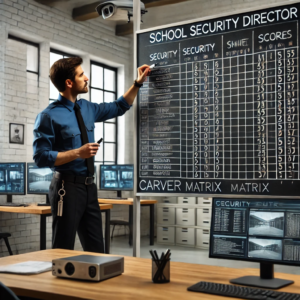
School security is more than just locks, cameras, and alarms. To effectively protect students, staff, and property, schools must adopt a strategic, proactive approach to risk assessment. That’s where the CARVER method comes in—a military-grade threat assessment tool used to identify vulnerabilities and prioritize security enhancements.
As a school security consultant, I’ve seen firsthand how reactive security measures fail to prevent incidents. The CARVER method helps school administrators, security directors, and law enforcement partners evaluate security risks with a structured, data-driven approach.
What is the CARVER Method?
Originally developed by the U.S. military and intelligence agencies, CARVER stands for:
• Criticality – How essential is the target to operations?
• Accessibility – How easily can an intruder reach the target?
• Recuperability – How quickly can the target recover after an attack?
• Vulnerability – How susceptible is the target to an attack?
• Effect – What would be the impact of an attack on this target?
• Recognizability – How easy is it to identify the target?
By applying numerical values to these six factors, security teams can quantify risk levels and prioritize security improvements based on real threats, not just assumptions.
Applying the CARVER Method to School Security
Let’s break down how the CARVER method can be used to identify and address security vulnerabilities in a school environment.
1. Securing High-Risk Areas
Schools have multiple access points and blind spots, making it crucial to determine which areas are most vulnerable. Applying CARVER, a security director may identify:
• Main Entrances (High Criticality, High Accessibility, High Recognizability)
• Parking Lots (High Vulnerability, High Accessibility, Medium Recognizability)
• Unmonitored Exterior Areas (High Vulnerability, Medium Accessibility, Low Recognizability)
• Classrooms & Common Areas (Medium Criticality, Medium Accessibility, Medium Effect)
Using CARVER scoring, the main entrance may be identified as the highest risk, leading to investments in:
✅ Stronger access control measures (badge systems, visitor screening, armed personnel)
✅ Surveillance upgrades (AI-based monitoring, real-time alerts)
✅ Physical reinforcements (ballistic-resistant glass, secured vestibules, locked entryways)
2. Using CARVER to Justify Security Investments
Many schools operate on tight budgets, making it difficult to justify security expenses. CARVER quantifies risk, making it easier to secure funding for necessary improvements.
For example, let’s say a school security team wants to purchase a small drone for monitoring blind spots behind buildings, parking lots, and wooded areas. A CARVER assessment might show:
Factor
Rating (1-10)
Justification
Criticality
8
These areas are prime locations for unauthorized entry and potential threats.
Accessibility
5
Limited coverage from existing cameras makes monitoring difficult.
Recuperability
7
If an incident occurs, response time may be delayed, increasing risk.
Vulnerability
9
These areas lack physical barriers or active monitoring.
Effect
8
A security breach could cause significant operational and reputational damage.
Recognizability
6
Intruders may not immediately recognize these areas as weak points, but security teams are aware of the gaps.
Total Score: 43/60 → High-priority security risk
Based on this assessment, a drone would provide:
✅ Enhanced real-time monitoring of high-risk areas
✅ Faster incident response with live aerial footage
✅ A cost-effective alternative to installing fixed cameras in multiple locations
Using this data-driven approach, school security teams can present concrete evidence to administrators and funding bodies, ensuring that resources are allocated where they are needed most.
The Role of a School Security Consultant in CARVER Implementation
Many school administrators lack the technical expertise to conduct a CARVER analysis, which is where a school security consultant becomes invaluable. A consultant can:
• Perform a full CARVER assessment of the school’s security infrastructure
• Identify and prioritize high-risk areas
• Develop a cost-effective security plan
• Train staff on emergency response and threat mitigation
• Coordinate with law enforcement for improved crisis management
By leveraging CARVER as a security framework, consultants help schools transition from reactive security to proactive prevention.
Conclusion: Strengthening School Security with Data-Driven Decisions
In today’s security landscape, schools cannot afford to rely on outdated or reactive measures. The CARVER method provides a structured, data-backed approach to risk assessment, allowing school leaders to prioritize threats, justify security investments, and enhance overall preparedness.
By integrating CARVER-based security planning and working with experienced school security consultants, schools can take a proactive stance in protecting students, staff, and the entire community.
Need help assessing your school’s security risks?
As a school security consultant, I specialize in CARVER-based security assessments, emergency preparedness, and risk mitigation strategies. Contact me today to discuss how we can make your school safer.